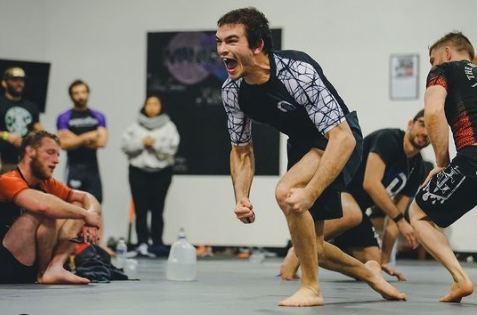Ski Resorts Work to Stay Open as COVID Cases Snowball
TELLURIDE, Colo. — The day after Thanksgiving, Dr. Jana Eller and Dr. Shiraz Naqvi were seated beside an outdoor fire pit at the base of Telluride Ski Resort, taking a short break from skiing.
The two physicians from Houston had driven more than 18 hours to get here for the holiday weekend, and they were staying (and preparing meals) in a rented home. They traveled with another couple and their kids, colleagues they’ve been “bubbling” with in Houston.
“We got a COVID test prior to leaving and will get another when we return,” Naqvi said.
The skiing itself doesn’t feel much different during the pandemic, Eller said, but “the après ski scene is just gone.”
In March, at the beginning of the pandemic, Colorado Gov. Jared Polis issued an executive order requiring the state’s ski resorts to close in response to COVID-19, which had hit the state’s ski towns early and hard. Now, as the resorts enter their busy season, the state has taken pains to avoid blanket closures even though cases of COVID-19 are reaching their highest levels yet.
How to stay open amid the pandemic is an issue resorts across the U.S. are facing. Mandatory face coverings have become the norm, but other COVID mitigation efforts vary by site. Vermont resorts ask skiers to certify their compliance with rules governing interstate travel during the pandemic when buying a lift ticket, and in Colorado’s Pitkin County (home to Aspen), visitors will be required to confirm they’ve had a negative COVID test result within 72 hours of travel or pledge to quarantine for 14 days after arrival or until they obtain a negative test result.
Telluride is an internationally renowned destination trying to operate safely while protecting the 8,000 or so permanent residents in the area. Located in a remote southwestern part of Colorado, its economy depends on tourism, and the resort posts as many as 6,500 visitors on its busiest days.
On Nov. 25, with its COVID case numbers skyrocketing and its positivity rate hitting 4.6%, San Miguel County, which includes Telluride, closed its bars and restricted its restaurants to takeout and outdoor dining only. Signs posted throughout the resort remind visitors of the “five commitments of containment” — wear a mask, maintain 6 feet of physical distance, minimize group size, wash hands frequently and, when you feel sick, stay home and get tested.
How bad would things have to get to close the resort? That’s hard to gauge, said Grace Franklin, public health director for the county. People are going to do what they will regardless, she said.
“If we shut down the ski resort, how many people will take to the backcountry and get injured or trigger avalanches where the impact is greater? It’s a ‘damned if you do, damned if you don’t’ situation,” Franklin said.
Instead, Franklin said, the question becomes “How do we create safer, engineered events so people have an outlet, but we minimize as much risk as possible?”
People from the same household can stand in line together and ride Telluride’s lifts next to one another, but when riding a lift with someone from another household, guests are asked to leave a vacant seat between them.
Skiing itself poses relatively little risk, said Kate Langwig, an epidemiologist at Virginia Tech. “You’re outside with a lot of airflow, you’ve got something strapped to your feet so you’re not in super close contact with other people, and most of the time you’re riding the lift with people in your group.”
Gathering in the lodge or bar is by far the biggest COVID risk associated with skiing, said Langwig, who grew up skiing in northern New York. “In my family, one of the things you do after a day of skiing is connect with friends and have a beer in the lodge,” and it’s this social aspect of skiing that’s too risky right now, she said.
In an effort to discourage tourists and residents from congregating, local governments, medical facilities and the ski resort released a co-signed letter in November urging people to cancel any plans to gather with those outside their immediate household and celebrate the holidays solely with people from their own household. Keeping the resort open will require everybody to do their part, said Lindsey Mills, COVID public information consultant for San Miguel County.
“We are not telling anybody not to come, at least not yet,” said Todd Brown, Telluride’s mayor pro tem. But local officials are broadcasting a strong message to everyone in the area — “Chill out. Don’t have the big party with five families.”
Officials aren’t worried only about coronavirus transmission; they’re also concerned about overtaxing their medical facilities. San Miguel County has an urgent care center but no hospital, and its medical center experienced a 22% staffing shortage at the end of November, mostly because so many employees are in quarantine. Hospitals in nearby Mesa County reached their ICU capacity last month, and other hospitals in the region are also pinched.
“We can’t have a situation where people break their legs on the slopes and we can’t get them care,” said Franklin.
To reduce contact in and around the lifts, Telluride workers have created “ghost lines” of empty space to ensure a 6-foot distance between groups while they’re waiting in lift lines. Face coverings are also required.
The resort has taken steps to facilitate physical distancing among visitors. Reservations aren’t required at Telluride, but lift tickets must be purchased in advance, and the resort can restrict ticket sales if necessary, said Jeff Proteau, vice president of operations and planning at the Telluride Ski Resort. Gondolas are operating with the windows open and each load is restricted to members of the same household.
To reduce contact in and around the lifts, workers have created “ghost lines” of empty space to ensure a 6-foot distance between groups while they wait in lift lines. People from the same household can stand in line together and ride the two- to four-person lifts next to one another, Proteau said, but when riding a lift with someone from another household, guests are asked to leave a vacant seat between them.
Langwig was a children’s ski instructor for many years and worries about ski school. “You interact pretty closely with the kids,” she said, noting that runny noses are common. “You spend a lot of time getting kids bundled up and to and from the bathroom.” This could be especially challenging if indoor spaces are closed, she said. “Hot chocolate breaks are one of the ways you get kids through the day, and that’s not safe anymore.”
In anticipation of visitors needing to take breaks to warm up, the resort has installed six temporary structures around the mountain with insulated ceilings and heated panels. When the sides are rolled up, they’re considered outdoor spaces, Proteau said, but they can be closed into confined spaces with limited occupancy as needed, especially on a blustery day.
The risk for most employees on the mountain should be relatively minimal, Langwig said, at least at work. “Lift attendants are outside wearing thick gloves and a mask most of the time. Compared to someone who works in a restaurant, their risk is pretty low.”
Employees are generally assigned to work in small groups that can be quarantined, if necessary, without wiping out a whole department, Proteau said. There’s also contact tracing in place for resort employees.
Arizona native Joey Rague moved to Telluride last year and works as a ski valet on the mountain. He said there’s a huge incentive among employees to keep the resort open. With affordable housing sparse in Telluride, “all of us are struggling seasonally to be able to pay rent.”
So far, he said, most visitors have been respectful and conscientious of the rules.
“It seems as though people understand that if we want to stay open, we have to come together,” he said.







